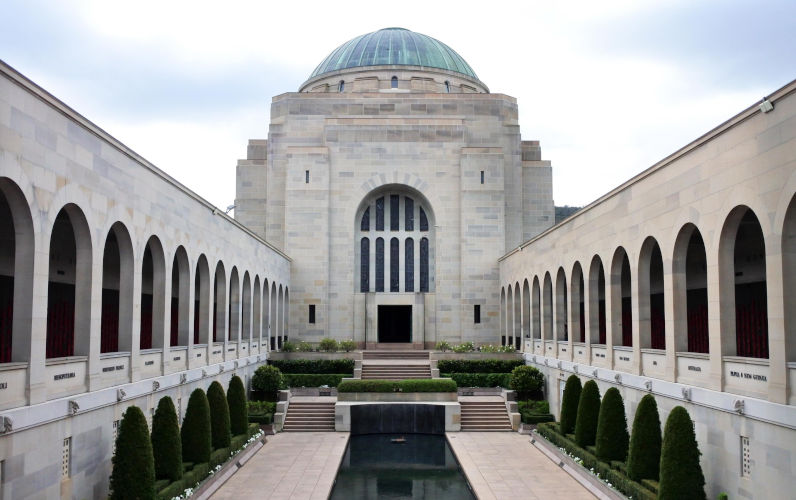The AWM, from behind the Pool of Reflection
July 16, 2023
As one of the pipers for the Australian War Memorial, I get a unique view of the crowds around the Pool of Reflection during the daily ritual that is the Last Post Ceremony.
Invariably, the faces are solemn and reflective. Not infrequently there are tears. On the way out, I move with the crowd. The mood is quiet, respectful and full of gratitude for the institution. There is a feeling that we have all been part of something special. The staff are invariably considerate and ready to gently assist, but never over-manage, all who visit, especially those a little more vulnerable than the rest.
This is what the War Memorial is about. Charles Beans vision, touched on each evening, was that the Memorial would give an understanding of the experiences of Australians at war and give families a place to grieve.
The Pearls posts of the president of the Medical Association for Prevention of War, Dr Sue Wareham, and former Memorial Registrar Richard Llewellyn leave me wondering if families exiting the redeveloped Memorial will look the same.
My worst fears are that, after a day of interactive experiences and videos, they will be herded through a merchandise shop and emerge with strollers weighed down in showbags and kids fighting over who broke the model plane/tank/aircraft carrier or who got the bigger score on Dambusters.
Were assured that all the additions will be in keeping with Beans vision, but it feels like we might be spending $500 million to fix something that isnt broken.
Our other national institutions must be scratching their heads, not least the National Library, with basic improvements to digitisation and photography as well as window replacement, heating ventilation and air-condition work, and the restoration of its roof all coming out of funding from its annual appropriation, some special projects funding and of course some insurance.
Ive always been in awe of the Memorial. As a kid, attending Anzac Day ceremonies in the 1960s and 70s, it was imposing, its stand-alone building a real statement of permanence and solemnity. Its exhibits were striking, too. My continuing memory of the World War I dioramas was shock at the obvious certainty of death. It emphasised the repeated message of my father (who served in World War II) that my generation must always work to avoid any further conflicts, and make the most of the peace so bravely won for us.
We were all able to walk up the front steps in those days, and kids even sat atop the stone walls beside those steps for the Anzac service. But no more.
An open letter to Prime Minister Morrison in 2020 from more than 70 prominent Australians, including Dr Wareham and Mr Llewellyn, noted the opposition of the Australian Heritage Council to the redevelopment.
The letter cited the loss of the free-standing form of the building, to be swamped by a huge glazed addition and the loss for most visitors of the existing commemorative entry.
That building cast a powerful image down Anzac Parade for those marching on April 25 (including me, as a Burns Club piper, in recent years), and it does the same on any other day of the year for any number of tourists and local commuters.
Its too late to stop the redevelopment, but not too late to hope the project might be modified and hopefully come in substantially under the mind-boggling budget.
In her recent article, Dr Wareham noted a current exhibit invited kids to see if you can bust the dam like the fabled 1943 RAF crews and their bouncing bombs. The exhibit mentioned almost as an aside that the raids killed about 2000 people and did not note that any of them might have been civilians.
Children could also play in a First World War trench absolutely authentic except for the absence of blown-off body parts, the terror that sent men mad, the constant shriek of shells overhead, the lice, the mud in which men drowned, and just about everything else that characterised trench warfare.
It did include a graphic panel about trench foot, but that was it on the down side.
Dr Wareham is worried by the various action stations in the Memorial already and her association has asked the Memorial about the process by which the community can have input into their new childrens galleries.
I guess there will be more of what Dr Wareham calls gee-whiz weaponry on display and I could probably live with that if, in the hoped-for absence of a gift shop, the only way out for visitors would be through sections on the United Nations, the costs of conflict, and how future wars might be avoided.
This was the message my father hammered home every Anzac Day. I see it again in the brass plaque recording the words of Prime Minister Keating every time I wait outside the Tomb of the Unknown Soldier to play pipes at the Last Post Ceremony:
It is not too much to hope he might enshrine a nation’s love of peace.
Beans vision, as the MC at the Last Post Ceremony recalls each night, was conceived at Pozieres in the bloody fighting of 1916.
Similarly, Eric Bogles song The Green Fields of France (also known as No Mans Land or Willie McBride) is a reflection on the grave of a young man who died in World War I. Maybe it could play on rotation as families exit the redeveloped Memorial:
Ah, young Willie McBride, I can’t help wonder why Do those that lie here know why did they die? And did they believe when the answered the cause Did they really believe that this war would end wars? Well the sorrow, the suffering, the glory, the pain The killing and dying, were all done in vain For young Willie McBride, it all happened again And again, and again, and again, and again.

